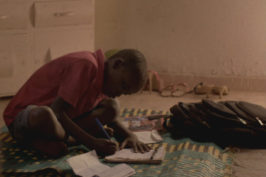Václav Marhoul‘s latest film, The Painted Bird, has created a lot of buzz since its premiere in Venice and Toronto last year.
Based on the acclaimed and controversial Jerzy Kosiński novel, The Painted Bird, is set in Eastern Europe towards the close of World War II. The film follows the journey of The Boy (Petr Kotlár), entrusted by his parents to an elderly aunt in the hopes the war will not reach him.
The Painted Bird is set up as a series of nine tableaux or chapters. In each one, we see The Boy grow up – physically and figuratively – as the world around him becomes more horrific due to war and the many atrocities people inflict on one another.
The old woman he has been entrusted to soon dies and The Boy is on his own, wandering through the countryside, from village to village, farmhouse to farmhouse, country to country. Along the way he meets another elderly woman who claims The Boy is a “vampire”. Others label him as “evil”, calling him a “misfortune” as is the case with Udo Kier‘s character of The Miller.
In a very key scene, one of the peasants (Lech Dyblik) shows The Boy the flight of a captive bird, whom he has painted white and then released back into its own flock. The bird is immediately shred to pieces because it looks different from the flock. That lesson reinforces all The Boy has come to know and will soon know better: difference is fatal.
Along the way he also meets a priest (Harvey Keitel), who saves The Boy from German soldiers. Unfortunately, the priest is lied to by a man (Julian Sands) who only adopts The Boy to use and abuse him for his own carnal pleasure.
Without going into more gruesome or graphic details, The Boy’s journey is filled with violence and horrors, most often perpetrated by the very adults he hopes will take care of him.
Ironically, (or perhaps not) kindness finds The Boy in the form two soldiers. First is Hans, a German soldier (Stellan Skarsgård) who spares his life after The Boy is caught trying to avoid being killed the Nazi soldiers assumed he was a Jewish boy trying to escape from a train headed to a concentration camp.
Second is Mitka (Barry Pepper), a Russian soldier who befriends The Boy and holds space with him. Mitka also teaches The Boy about revenge and how to use a gun, which seems to take away from the kindness he’s bestowed upon the child yet forces The Boy to grow up even more. This is a complicatedly endearing scene.
It is after this chapter with Mitka that The Boy is sent to an orphanage. Here he continues to get into trouble, get insulted by adults on the street, but eventually is spared and rescued in a matter of speaking.

Václav Marhoul’s The Painted Bird.
Courtesy of IFC Films. An IFC Films Release.
At 2 hours and 49 minutes, The Painted Bird can seem and feel exhausting. The story is grim, sad and horrific to be sure. Just when one thinks it cannot get any worse, it keeps going. The Boy’s life is not pretty nor is it happy. Nonetheless, The Boy is the embodiment of that painted bird from that key scene. One comes to understand The Boy has been labeled as ‘other’ and thrown into the world only to be shred to pieces by adults. So why sit with it?, you may ask.
From my perspective, I was invested in the main character. The Boy drew me in. Those beautiful eyes, innocent at first, drew me in. The sadness and anger in his eyes as life became harder and harder, drew me into his flight and plight. Ptr Kotlár, although a non-professional child actor, plays The Boy with such emotion and great screen presence. He is the reason I sat through the entire film. As I watched his journey, I began to think The Boy embodies all of those who have suffered and continue to suffer the atrocities of war. He may also embody all of those who have lived through many other atrocities of life.
The film also made me think whether many objections to it come from seeing a child be the victim of so much horror. I wonder this, especially, when audiences are used to seeing a lot of graphic violence on-screen more often than not. In essence, is the film too brutal because as audience members, we witness this child’s suffering and perhaps feel powerless or hopeless as quiet observers? Perhaps this is one of the points Marhoul is trying to make in The Painted Bird. It could be that bearing witness will make some of us question humans’ evil nature to inflict pain on one another, while also wondering how can we change from this ‘evil nature’, if you will. I am not defending the graphic nature of the film, but I did have these thoughts post screening. After all, these opinions are but my own.
Cinematically speaking however, The Painted Bird is a really well done production. Marhoul, as screenwriter and director, chose to film it in Cinemascope in pristine 35mm black and white stock film. In his words, the goal was to create a series of chapters that take “[the] protagonist on a journey to the very heart of the dark human soul…” Taking colour out of the equation does emphasize this dark subject matter. It also helps emphasize The Boy as the central figure.
Vladmir Smutný‘s cinematography is meticulously rich and intricate. The use of light, shadows, close-ups and tracking shots throughout the various chapters are stand outs. There is also minimal dialogue and music used throughout the film. These conscious decisions help evoke the dark mood of the film and allow one to focus on The Boy and his journey, in my opinion. Some of the work here is reminiscent of Béla Tarr‘s films.
Marhoul described wanting “to film in a mixture of Slavic languages, while German and Russian soldiers speak in their native tongues.” In his view the story would lose its credibility had it been filmed in English, which is understandable. Locations are also important to the story, as they help move the narrative along. He described the film’s pacing as being “set by the pace of a flowing river, unpredictable and continually shifting in its rhythms…”
Combine all this with the work of Pavel Rejholec (Sound Designer), Luděk Hudec (Editor), Helena Rovna (Costume Designer), and Ivo Strangmüller (Make-Up And Hair Designer), The Painted Bird is a cinematically strong film. From this perspective, I understand why the Czech Republic chose it as its Foreign Film submission to the Oscars.

Courtesy of IFC Films. An IFC Films Release.
The Painted Bird is not an easy film to sit through. I do not regret sitting with it, as it posits some questions worth considering. It also brings up the themes of good, evil, religion, politics, among a few others. I encourage breaks where needed should you choose to watch it. It is a layered cinematic, but controversial and complicated film.
Rent or buy The Painted Bird on Google Play, Apple TV, and other online screening platforms.








 The 64th #Toronto Outdoor Art Fair, Canada’s
The 64th #Toronto Outdoor Art Fair, Canada’s

 Hiding at a fave spot bef
Hiding at a fave spot bef


